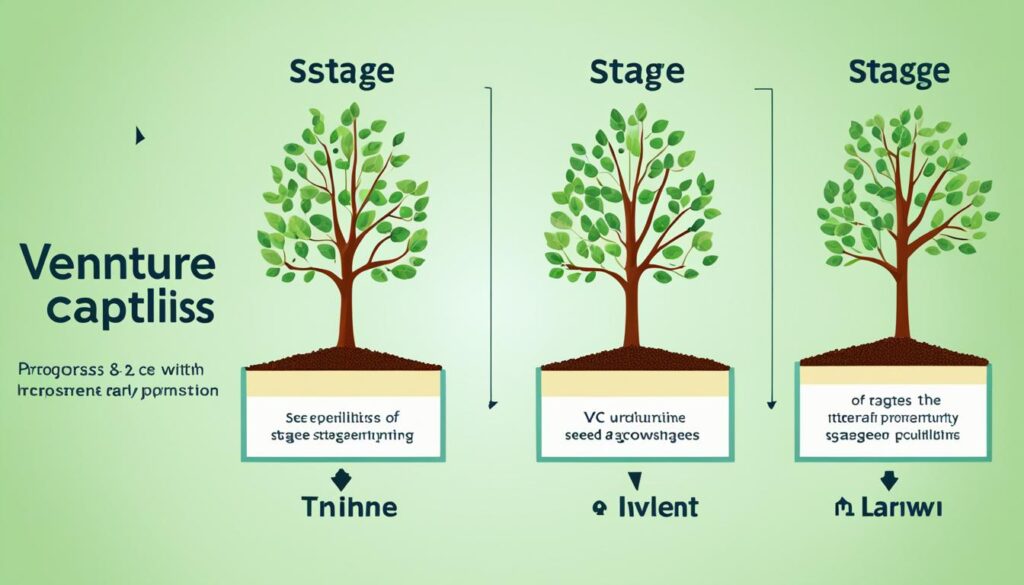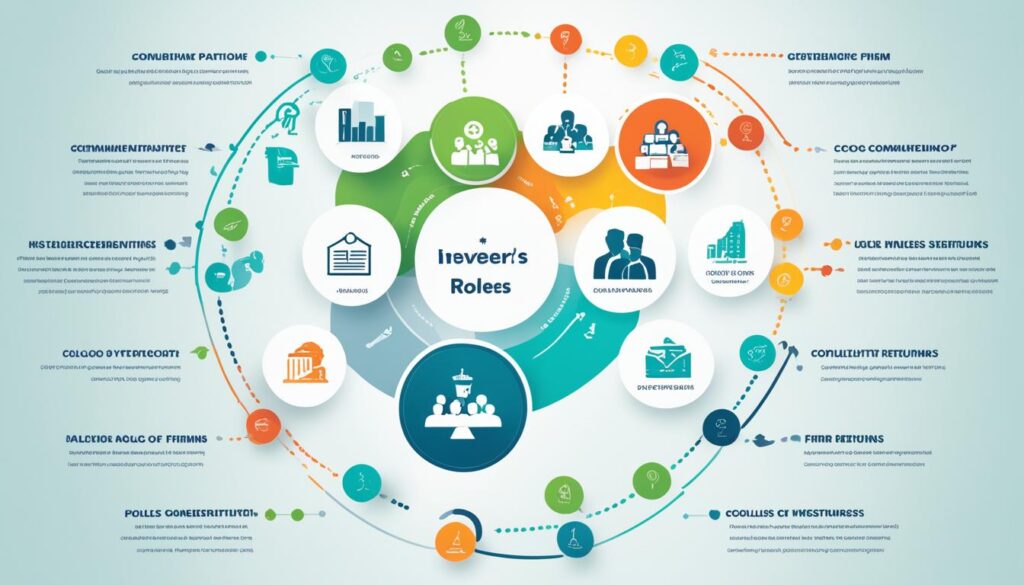Ever wondered what venture capitalists (VCs) get in return for the money they invest in startups? It’s a fascinating question that delves into the core dynamics of the venture capital industry. VCs invest in emerging companies with the expectation of substantial returns, but the path to those returns can be unpredictable and often follows a power-law distribution. As we explore this topic, we’ll uncover the intricate workings of VC investments, their targeted returns, and the strategies they employ to construct diverse portfolios that can yield outsized rewards.
Key Takeaways
- Venture capitalists aim for a return of at least 10 times their initial investment over 5-7 years.
- VC returns often follow a power-law distribution, with a few “home runs” driving the majority of the fund’s returns.
- VCs diversify their portfolios to offset the high failure rate of individual investments.
- Successful VC-backed companies can generate massive returns for their investors.
- Understanding the VC investment process and dynamics is crucial for entrepreneurs seeking funding.
Understanding Venture Capitalists and Their Role
Venture capitalists (VCs) are private equity investors who provide capital to companies with high growth potential in exchange for an equity stake. VCs invest in startups and small companies that wish to expand but don’t have access to the public equities markets. Venture capital firms are usually formed as limited partnerships, where the partners invest in the VC fund. A committee is generally tasked with making investment decisions, and once promising emerging growth companies are identified, the pooled investor capital funds them in exchange for a sizable equity stake.
Definition and Key Characteristics of Venture Capitalists
Contrary to common belief, VCs do not typically fund a startup at its outset. Instead, they target firms that generate revenue and need more funding to commercialize their ideas. The VC fund will buy a stake in these firms, nurture their growth, and look to cash out with a strong return on investment. Venture capitalists typically look for companies with a strong management team, a large potential market, and a distinctive product or service with a solid competitive advantage. They also look for prospects in industries with which they are familiar or have expertise while having the chance to buy a large percentage of the company so they can influence its direction.
The Venture Capital Investment Process
Startups often go through various stages of growth, and venture capitalists can be involved in any of these stages, but they are usually focused on the startup and growth stages. The typical company stages include incubation (company formation and business model development), seed (first capital contribution), startup (the company begins to scale), growth/later stages (expansion into new markets, increased revenue), and exit (resale of the company or initial public offering). VCs tend to target firms in the startup and growth/later stages, providing capital to help them scale and commercialize their products or services.
Stages of Company Growth and VC Involvement
Startups often go through various stages of growth, and venture capitalists can be involved in any of these stages, but they are usually focused on the startup and growth stages. The typical company stages include incubation (company formation and business model development), seed (first capital contribution), startup (the company begins to scale), growth/later stages (expansion into new markets, increased revenue), and exit (resale of the company or initial public offering). VCs tend to target firms in the startup and growth/later stages, providing capital to help them scale and commercialize their products or services.

The Venture Capital Structure and Firm Dynamics
Venture capital firms are typically structured as limited partnerships (LPs), where the partners invest in the VC fund. The venture capital firm acts as the
general partner (GP)
, while the other companies or individuals, such as high-net-worth individuals, insurance companies, pension funds, foundations, and corporate pension funds, are the
limited partners (LPs)
. All partners have part ownership of the fund, but the GP controls where the money is invested.
General Partners and Limited Partners in VC Firms
The general partners (GPs) are the venture capital firm itself, which is responsible for managing the fund and making investment decisions. The limited partners (LPs) are the investors who provide the capital to the VC fund, but they have a more passive role and do not actively manage the investments.
Roles Within a Venture Capital Firm
The roles within a venture capital firm can be broken down into three main positions:
- Associates – Analyze business models, industry trends, and sectors, and introduce promising companies to the firm’s upper management.
- Principals – Serve on the boards of portfolio companies, identify investment prospects, and negotiate deal terms.
- Partners – Primarily identify areas or specific businesses to invest in, approve deals, and represent their VC firms.
These distinct roles within a VC firm help to ensure a thorough evaluation of investment opportunities and effective management of the firm’s portfolio companies.

Historical Perspective on Venture Capital
The history of individuals and firms investing in high-risk and high-reward ventures is centuries old, but the U.S.’s first modern venture capital firms started in the mid-20th century. Georges Doriot, a Frenchman who moved to the U.S., became president of the American Research and Development Corporation (ARDC) in 1946, which was the first publicly funded venture capital firm. ARDC enabled startups to raise money from private sources other than just wealthy families. The VC industry continued to evolve, with the passage of the Investment Act of 1958 enabling small business investment companies to be licensed by the Small Business Administration.
Origins and Evolution of the VC Industry
Fairchild Semiconductor, one of the earliest and most successful semiconductor companies, was the first venture capital-backed startup, setting a pattern for venture capital’s close relationship with emerging technologies in the San Francisco, California, area. Well-known early venture capitalists include Georges Doriot, the founder of ARDC, as well as the founders of firms such as Morgan Holland Ventures and Greylock Partners. Venture capital has since grown into a hundred-billion-dollar industry, with notable modern-day VCs including Jim Breyer (an early Facebook investor), Peter Fenton (an early investor in X), and Peter Thiel (the co-founder of PayPal).
Pioneering Venture Capital Firms and Investments
The origins of the VC industry and the evolution of VC have been shaped by the actions of pioneering VC firms and their early VC investments. These influential VC firms and their visionary investments have laid the foundation for the modern venture capital landscape, driving innovation and entrepreneurship across various sectors.

What do VC get in return?
Venture capitalists typically aim for a return of at least ten times their initial investment over five to seven years. This translates to expected returns of 100x for VC seed-stage investments, 10-15x for Series A investments, and 3-5x for late-stage investments. The difference in reflects the lower risk and information asymmetry as companies progress through funding stages. Seed-stage VCs have the highest return target but also the highest failure rate, while late-stage VCs have lower return targets but more certainty about the company’s prospects.
often follow a distribution, where a small number of highly successful “home run” investments generate the majority of a fund’s returns. To achieve their target returns, VCs construct a portfolio of investments, expecting that out of a typical portfolio of at least 10-20 companies, one or two will be “home runs,” two to three will have moderate success, four to five will only return the initial capital or generate a small profit, and four to five or more will fail. This portfolio approach allows VCs to offset the high failure rate of individual investments with the outsized returns of their top-performing companies.

VC Expected Returns and Risk-Reward Dynamics
Venture capitalists typically aim for a return of at least 10 times their initial investment over a 5-7 year time frame. This translates to targeted internal rates of return (IRRs) of 20-35% for their overall VC portfolio returns. However, these returns are not guaranteed, as VC investments carry a high degree of risk due to the uncertainty involved with new and unproven companies. VCs construct diversified portfolios to offset the high failure rate of individual investments with the outsized returns of their top-performing “home run” companies.
Typical Return Expectations and Time Frames
Venture capitalists typically aim for a VC return expectations of at least 10 times their initial investment over a 5-7 year VC investment timeframes. This ambitious target reflects the higher risk profile of early-stage investments and the potential for substantial upside if a startup becomes a market leader. While some investments may exceed these expectations, many others will not meet the target, leading to an overall portfolio return that aims to achieve the desired IRR range.
Risk Factors and Challenges in VC Investing
VC investment risks are inherent to the venture capital model, as VCs back unproven companies facing significant market, competitive, and execution challenges. Additionally, VC investing challenges arise from the illiquid nature of VC investments, as investor capital is typically locked up for several years until an exit opportunity, such as an acquisition or initial public offering (IPO), presents itself. To navigate these risks and challenges, VCs must carefully VC portfolio management by diversifying their investments and aiming for a few high-performing “home run” companies to drive overall fund returns.

Pros and Cons of Venture Capital Financing
The advantages of VC financing include access to substantial growth capital, valuable industry expertise and strategic guidance from experienced venture capitalists, and the potential for high returns if the startup is successful. Venture capitalists can provide startups with the necessary resources and networks to rapidly scale their business, opening doors to new markets and accelerating product development.
However, the disadvantages of VC financing also need to be carefully considered. Accepting venture capital typically means surrendering a significant equity stake in the company, leading to a loss of some control and decision-making power for the founders. Additionally, venture capitalists often impose aggressive growth targets and timelines to achieve their targeted return expectations, which can create immense pressure on the startup team.
Ultimately, the considerations for VC funding require entrepreneurs to weigh the pros and cons against their long-term vision and goals for the company. Securing VC investment can provide a substantial boost to a startup’s growth, but it also comes with trade-offs that must be evaluated thoroughly. Entrepreneurs should carefully assess whether venture capital financing aligns with their company’s needs and their personal aspirations before embarking on the fundraising journey.

Venture Capital in Different Industries and Sectors
Venture capital has historically had a close relationship with emerging technologies, particularly in the San Francisco Bay Area. Pioneering tech and software startups like Fairchild Semiconductor were among the first VC-backed companies, setting a precedent for VCs to focus on high-growth potential in innovative industries. Today, technology and software startups continue to be a major focus for venture capital, as VCs seek to identify the next disruptive technologies and platforms with the potential for outsized returns.
Life Sciences and Healthcare Ventures
In addition to technology and software, venture capitalists also actively invest in the life sciences and healthcare sectors. These industries often require significant upfront capital for research, development, and clinical trials, making them a natural fit for VC funding. Life sciences and healthcare startups, such as those in the biotech, medical device, and pharmaceutical industries, can attract VC investment if they demonstrate strong scientific foundations, promising clinical data, and the potential for high-value exits through acquisitions or public offerings.

Trends and Future of the Venture Capital Landscape
Emerging Investment Strategies and Models
The venture capital industry is continuously evolving, with new investment strategies and models emerging to adapt to changing market conditions and investor preferences. Some of the recent trends include the rise of specialized VC funds (e.g., sector-focused, stage-focused), the growth of corporate venture capital, the increasing involvement of institutional investors and family offices, and the exploration of alternative investment structures (e.g., SPACs, direct listings). VCs are also exploring ways to streamline their investment process, leverage data and technology, and diversify their portfolios to navigate the inherent risks and uncertainty in the startup ecosystem.
Impact of Technology and Regulatory Changes
Technological advancements and regulatory changes have also had a significant impact on the venture capital industry. The proliferation of digital tools and platforms has transformed how VCs identify, evaluate, and monitor their investments. Additionally, shifts in regulations, such as the JOBS Act and changes to securities laws, have opened new avenues for VC fundraising and investment, including the rise of crowdfunding and the increased participation of individual investors. As the startup ecosystem and financing landscape continue to evolve, venture capitalists must adapt their strategies and practices to stay ahead of the curve and capitalize on emerging opportunities.

Success Stories and Notable VC-Backed Companies
The venture capital industry has been instrumental in the success of many high-profile companies that have gone on to achieve significant exits, either through initial public offerings (IPOs) or acquisitions. Some notable examples include tech giants like Google, Facebook, and Uber, as well as disruptive startups in other industries like SpaceX, Airbnb, and Moderna. These “home run” VC investments have not only generated outsized returns for the VCs involved but have also captured the public’s imagination and cemented the venture capital industry’s reputation for identifying and nurturing transformative businesses.
Influential Venture Capitalists and Their Investments
The venture capital industry has also been shaped by the actions and investments of influential individual VCs. Some of the most well-known and successful VC investors include Jim Breyer, an early investor in Facebook; Peter Fenton, an early investor in X (formerly Twitter); and Peter Thiel, the co-founder of PayPal. These VCs and others like them have developed reputations for identifying promising startups, providing strategic guidance, and generating outsized returns for their investors, further solidifying the crucial role that venture capital plays in driving innovation and entrepreneurship.
Navigating the VC Funding Process as an Entrepreneur
Entrepreneurs seeking VC funding must navigate a rigorous VC funding process to secure the necessary capital to scale their business. This process begins with thoroughly preparing a comprehensive business plan, financial projections, and a captivating pitch presentation that effectively communicates the company’s vision, market opportunity, and growth potential to potential VC investors.
Preparing for and Pitching to VCs
Entrepreneurs must be well-versed in the VC pitch preparation process, as VCs will conduct extensive VC due diligence to scrutinize every aspect of the business, from the management team to the product roadmap and customer traction. By understanding the VC funding process and aligning their startup’s goals with the VC’s investment criteria, entrepreneurs can increase their chances of securing the necessary capital to propel their business forward.
Negotiating Terms and Valuation
Once a VC firm expresses interest in investing, entrepreneurs must then navigate the VC term sheet negotiation process. This includes discussing and agreeing on the startup valuation, the equity stake the VC will receive, and other contractual terms, such as board representation, liquidation preferences, and exit provisions. Entrepreneurs must be well-versed in standard VC investment terms and be prepared to negotiate effectively to secure the best possible deal for their company and its long-term success, while also aligning with the VC’s expectations and investment goals.

Conclusion
Venture capitalists play a crucial role in funding and nurturing high-growth potential startups, providing the necessary capital, industry expertise, and strategic guidance to help these companies scale and succeed. By understanding the VC investment process, return expectations, and industry dynamics, entrepreneurs can better navigate the VC funding landscape and increase their chances of securing the financing they need to turn their business vision into reality.
As the venture capital industry continues to evolve, driven by technological advancements, regulatory changes, and the pursuit of outsized returns, its impact on the entrepreneurial ecosystem will remain significant, shaping the future of innovation and economic growth. The venture capital industry’s ability to identify and nurture promising startups has been instrumental in the success of many high-profile companies, showcasing the crucial role that VCs play in driving the entrepreneurial ecosystem forward.
Overall, the venture capital industry’s key investment dynamics and importance of VC funding underscore the pivotal role it plays in shaping the future of innovation and economic growth. As the entrepreneurial landscape continues to evolve, the venture capital industry will remain a driving force, fueling the ambitions of ambitious founders and transforming their visions into reality.
